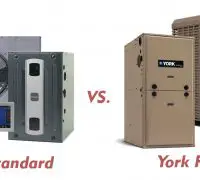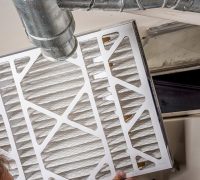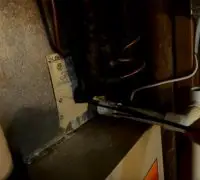If you're looking to fix or replace your Heating or A/C system, we can connect you with a reliable and cost-effective professional in your area.
With gas furnaces starting and stopping all the time, they’re exposed to high wear and tear, which is why furnaces will develop some problems throughout their use.
Luckily for customers, modern furnaces today come with control panels with led code flashes informing you of the problem on your furnace. A 4 blink for the Goodman furnace means an “open limit” or an “open high-temperature switch.” “open rollout switch” can also be signaled with four blinks, and overheating of the furnace is a prevalent cause.
Checking and cleaning the filters may solve the issue, but you should also see any blockages in the flue. Some tightening of the wiring may be necessary for making the furnace run again.
Page Table of Contents
What’s an excellent way to clean the filters on your furnace?
No matter how great the furnace and its filters may be, it’s only a matter of time until you will have to clean the filters. As a matter of fact, cleaning the filters to remove dust, dirt, and debris is part of the maintenance you give to the furnace. Not all filters are reusable, but the reusable models are marked that way and are made with plastic-like materials. When the filter isn’t reusable, you should check your local Goodman supplier for a replacement.
Which steps should you take for cleaning the filters?
Even if cleaning the filters on your furnace sounds easy, you should be meticulous and careful while doing it. Furnaces are complicated devices, and you should always follow instructions accurately, even when it’s an effortless job like cleaning the filters. Here are the steps:
Step 1
Begin with turning off the furnace; you should never remove the filter with your furnace operating. Switch the furnace off every time you want to work on your furnace, though. Go over the user manual if you have difficulties figuring out how to turn off the furnace.
Step 2
Find the filter, which should be inside the furnace. It can also be mounted inside the furnace or the air vent, with an arrow informing the airflow direction.
Step 3
You should note the airflow’s direction with a sharpie. Use the sharpie for drawing the arrow pointing in the airflow’s direction right on or close to your furnace. It’s how you know that you’ll put the filter back in the correct direction.
Step 4
Continue with removing the filter. Most of the time, you won’t need any particular tools; use your hand for grasping the filter, sliding it out of place.
Step 5
Only reusable filters can be clean, so don’t clean it if the filter doesn’t have a plastic frame. Most of the time, disposable filters will feature a cardboard frame. If that’s your situation, removing the current filter and mounting a new filter is the solution.
When your furnace doesn’t come with reusable filters, make sure to write down the size and kind of the filter so that you precisely know what to buy. You always have to buy the same size and type of filter for the furnace.
Step 6
Use some water for rinsing the dust away. As you can see, it’s not rocket science to clean the filter, and you won’t need any particular cleaners either. Keep the filter under some running water for removing dust, dirt, or debris trapped in the filter. Make sure you turn the filter all around so that you clean every side.
Step 7
It would help if you always allowed the filter to dry before placing it back ultimately. Ideally, it would help if you let the filter air dry.
Your house’s temperature will affect how fast/slow the filter will air dry, but never install it back until it’s scorched.
Step 8
You won’t need any tools for placing back the filter, as you will effortlessly slide it back in its place. As long as you also pay attention to the arrow, placing it in the proper airflow direction, your problem should be solved.
What if replacing the filter is the solution?
Sometimes, the filter may be far from cleaning, and you will have to replace it. Filters may also get damaged, but it’s less complicated to replace than to repair a filter. Here’s how to do it correctly:
Step 1
Once again, it would help if you began by turning off the furnace. Make sure you know where the filter access door is mounted too.
Pull the access door toward you so that you may access the filter.
Step 2
Always carefully pull the filter with your hand. Sometimes, some nudging may be required, as the filter is supposed to fit snug inside the unit. Be careful not to rip the cardboard. You can throw it into the garbage.
Step 3
Use a vacuum for dusting the dirt who dropped onto the floor, but don’t also forget to vacuum the furnace’s housing.
Step 4
Slide in the replacement filter in the same direction and position as the current filter. Turn your furnace back on after closing the access door.
Tip
The installation of the Goodman furnace will affect how you replace the filter. Ensure you check the user manual and contact the professionals if you feel like the replacement of the filter is tricky for you. Never make the furnace operate again unless you’re 100% sure that the new filter is the right model.
Needless to say, running a furnace without any filter in it is never a good decision.
How should we address a clogged furnace flues problem?
Clogged furnace flues can also cause a four blink limit switch, so you should never postpone fixing it. The duct on the furnace is supposed to eliminate carbon monoxide and various gases produced throughout the combustion process outside the house. The damaged or clogged vent will stop it from running its job, which poses a high risk for your health and even life. On a side note, every heating appliance requires constant inspection and cleaning to reduce carbon monoxide poisoning risk.
What are the common signs of clogged flues?
Birds, small animals, ash, and masonry debris may block the flue pipe of the stove. Any of these things falling into the chimney can block the correct venting of combustion gases. In time, the furnace will build upscale from the gas byproducts and moisture, blocking the flue.
Water streaking on the vent, rust, flue, or chimney can block the duct. When air isn’t circulating efficiently, moisture will build inside the pipes, causing rust.
Soot
Soot around the furnace is a sign. It can build up in the venting system, blocking it. Check for white residue on the brick of the furnace vents through a masonry chimney. It’s a sign that mineral salts go through masonry as there’s too much moisture inside the chimney.
The flame’s color isn’t always an accurate factor of carbon monoxide presence, but when the flame changes color (from blue to yellow), the level of carbon monoxide has risen, causing the blocked flue.
Is it dangerous?
Damaged or blocked furnace flue will not allow combustion gases to go outside, but make them get released inside your house. Once they’re inside, they will recirculate, and carbon monoxide will be present in the air from the combustion process. Carbon monoxide levels increasing, and the buildup may become deadly for you and your family.
Vomiting, nausea, fatigue, dizziness, loss of consciousness, or difficulty breathing are signs of carbon monoxide poisoning. Go outside immediately, open all windows and doors, turning off all combustion appliances in your house.
Safety tip
The venting system has to be cleaned every year. Even if the particulate buildup on the furnace isn’t as significant as with the fireplace flue, it can still impact the performance of the vent after some. Carbon monoxide poisoning is a dangerous matter, so you should contact professionals to clean and check the flue even if your furnace is running correctly. Only professionals will identify any buildup or blockage inside the furnace flue and fix the problem.
We can definitely connect you with a trusted provider in your area to repair, replace or maintain your heating and A/C systems. Why not let us find a professional for you?





